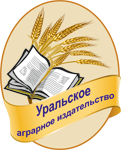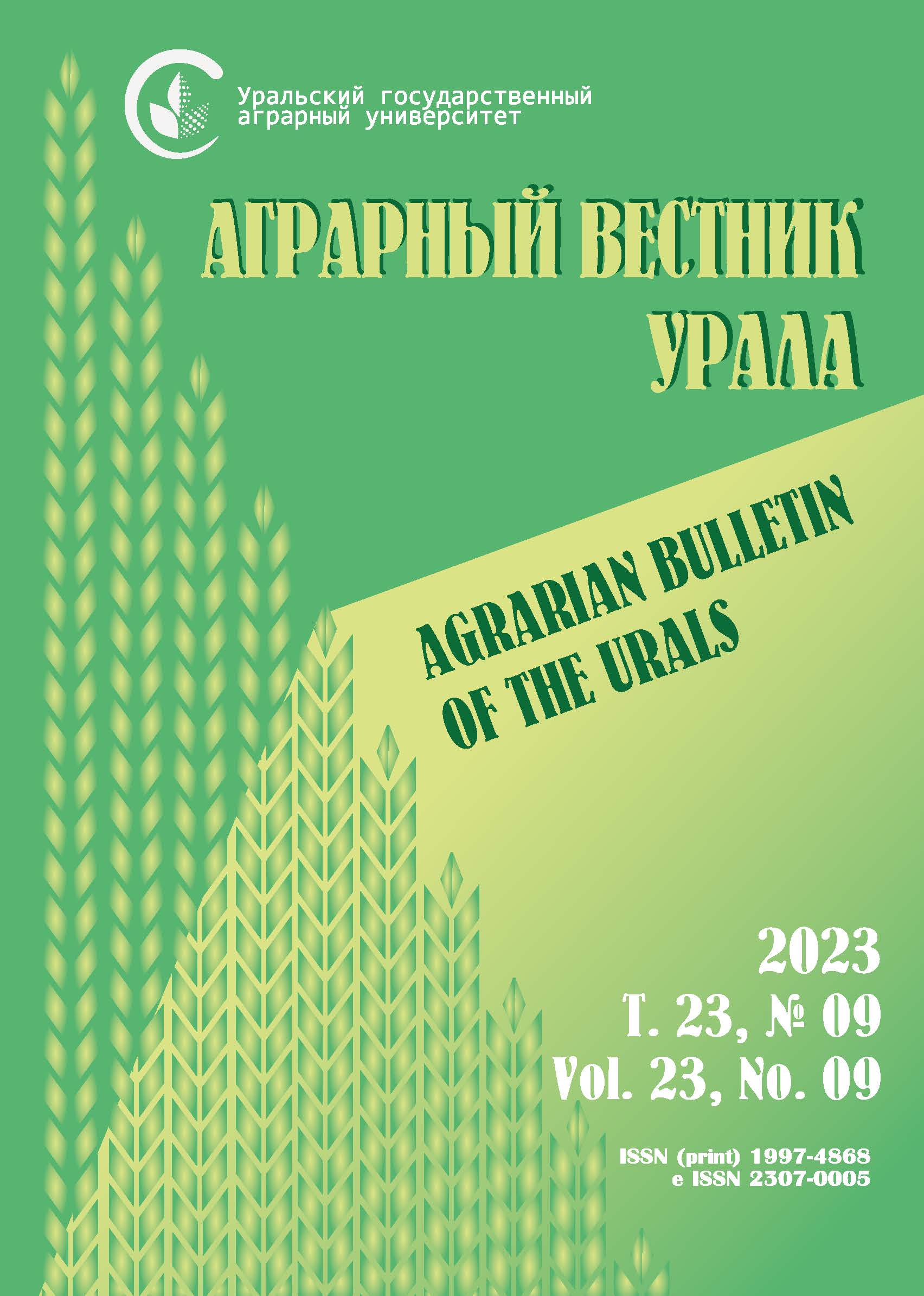Ekaterinburg, Ekaterinburg, Russian Federation
Abstract. In experiments conducted in 2021–2022. on the basis of the educational and experimental farm of the Ural State Agrarian University, studies were carried out on the influence of the feeding area and planting dates on the productivity and biochemical composition of perennial onions. The territory of the Middle Urals is located in a difficult climatic zone, with severe winters and warm summers. The weather in this area can change very quickly, and therefore, for cultivation in the Middle Urals, plants should be selected that will easily endure the vagaries of the weather, including green crops. These characteristics correspond to perennial onions, which are able to produce high yields of green leaves even in risky farming. Good resistance to pathogens, less susceptibility to pests compared to onions, as well as a wide variety of species that differ in external characteristics and taste make perennial onions excellent plants for obtaining valuable vitamin greens. The purpose of the study: to study the biological characteristics of perennial onions, as well as to find out the effect of the feeding area on their yield and biochemical composition. Methods. In the experiments, the following factors affecting the yield of perennial onions were investigated: leaf length, number of leaves per plant, the appearance of flower stalks, individual plant productivity. Results. In the course of the study, it was found that the highest yield is observed in all types of onions when grown with a distance in a row of 5 cm, the highest individual productivity was shown by batun onion plants when grown in a row with a distance between plants of 15 cm and slime onion with a distance between plants in a row of 25. In addition, there was a deterioration in the biochemical composition of the leaves of all the studied types of onions when planting in 2022 compared to 2021 and an increase in the concentration, electrical conductivity and acidity of cell sap in 2022 compared to 2021. Scientific novelty. Ledebur onion is the least studied of the onion species presented in the study, but it has good commercial and nutritional properties. Previously, this type of onion was not studied in the Middle Urals as a vegetable plant.
perennial onions, Allium fistulosum, Allium nutans, Állium schoenoprásum, Allium odorum, Allium ledebourianum, feeding area
1. Seredin T. M., Ivanova M. I., Shumilina V. V. [i dr.]. Mnogoletnie luki, ispol'zuemye v pischevyh, dekorativnyh i lekarstvennyh celyah // Sovremennoe sadovodstvo, 2020. № 1. S. 40-48. DOI:https://doi.org/10.52415/23126701_2022_0304. DOI: https://doi.org/10.24411/2312-6701-2020-10106; EDN: https://elibrary.ru/QTSVCR
2. Shishkina E. V., Zharkova S. V. Mnogoletnie vidy lukovyh kul'tur v Sibiri // Mezhdunarodnyy zhurnal gumanitarnyh i estestvennyh nauk. 2019. № 1-1. S. 118-121. DOI:https://doi.org/10.24411/2500-1000-2018-10438. EDN: https://elibrary.ru/YWWPQL
3. Shishkina E. V., Zharkova S. V. Sorta mnogoletnih vidov lukovyh kul'tur, adaptirovannye k usloviyam yuga Zapadnoy Sibiri // Vestnik Altayskogo gosudarstvennogo agrarnogo universiteta. 2019. № 9(179). S. 32-41. EDN: https://elibrary.ru/TADSUH
4. Ivanova M. I., Buharov A. F., Baleev D. N. [i dr.]. Biohimicheskiy sostav list'ev vidov Allium L. v usloviyah Moskovskoy oblasti // Dostizheniya nauki i tehniki APK. 2019. № 5. S. 47-50. DOI:https://doi.org/10.24411/0235-2451-2019-10511. EDN: https://elibrary.ru/ZNDOCX
5. Kukushkina T. A., Fomina T. I. Soderzhanie biologicheski aktivnyh veschestv v zelenoy masse mnogoletnih lukov (Allium L.) // Agrarnyy vestnik Urala. 2021. № 4 (207). S. 85-92. DOI:https://doi.org/10.32417/1997-4868-2021-207-04-85-92. EDN: https://elibrary.ru/WDLVZD
6. Shirshova T. I., Beshley I. V., Golubkina N. A. [i dr.]. Essencial'nye mikronutrienty - komponenty antioksidantnoy zaschity v nekotoryh vidah roda Allium // Ovoschi Rossii. 2019. № 1 (45). S. 68-79. DOI:https://doi.org/10.18619/2072-9146-2019-1-68-79. EDN: https://elibrary.ru/ZXJJLV
7. Seredin T. M., Golubkina N. A., Agafonov A. F. [i dr.]. Izmenenie osnovnyh biohimicheskih pokazateley v mnogoletnih lukah v zavisimosti ot vozrasta rasteniy // Sovremennoe sadovodstvo, 2022. № 3. C. 40-48. DOI:https://doi.org/10.52415/23126701_2022_0304. EDN: https://elibrary.ru/ZMVYRH
8. Lyubchenko A. V., Semenov V. A. Adaptivnost' i kachestvo produkcii lukov (Allium L.) v usloviyah predgornoy zony Severo-Zapadnogo Kavkaza. Maykop: Izdatel'stvo «Magarin Oleg Grigor'evich», 2019. 160 s. EDN: https://elibrary.ru/UMFLPA
9. Shishkina E. V., Zharkova S. V. Skrining obrazcov luka-batuna, introducirovannyh v usloviya yuga Zapadnoy Sibiri // Mezhdunarodnyy zhurnal gumanitarnyh i estestvennyh nauk. 2019. № 10-1. S. 9-11. DOI:https://doi.org/10.24411/2500-1000-2019-11597. EDN: https://elibrary.ru/NCVVVX
10. Davletbaeva O. R., Hovrin M. G., Ibragimbekov M. G. Luk-batun Long Tokio v odnoletney kul'ture v Moskovskoy oblasti // Kartofel' i ovoschi. 2018. № 5. S. 13-14. EDN: https://elibrary.ru/XNJCNN
11. Tymchenko L. N., Karpuhin M. Yu. Biologicheskie i biohimicheskie osobennosti i perspektivy ispol'zovaniya Allium schoenoprasum L // Vestnik biotehnologii. 2022. № 1 (30). http://bio.urgau.ru/ru/2-29-2022/7-02-2022, data obrascheniya: 10.05.2023g.
12. Shishkina E. V., Zharkova S. V. Svetloyar - sort mnogoletnego luka-slizuna // Vestnik Altayskogo gosudarstvennogo agranogo universiteta, 2020. № 9 (191). S. 23-28.
13. Kazakova A. A. Kul'turnaya Flora SSSR. Luk. T. 10. Leningrad: Kolos, 1978. 264 s.
14. Tuhvatullina L. A. Biologicheskie osobennosti luka dushistogo v kul'ture // Vestnik KrasGAU. 2022. № 4 (181). S. 12-16. DOI: https://doi.org/10.36718/1819-4036-2022-4-12-16; EDN: https://elibrary.ru/OILXBL
15. Tymchenko L. N., Karpuhin M. Yu. Issledovanie vshozhesti semyan mnogoletnih lukov pri ih predvaritel'noy obrabotke biopreparatami i barbotirovaniem // Ot importozamescheniya k eksportnomu potencialu: nauchno-innovacionnoe obespechenie proizvodstva i pererabotki produkcii rastenievodstva: materialy mezhdunarodnoy nauchno-prakticheskoy konferencii. Ekaterinburg, 2021. S. 146-149. EDN: https://elibrary.ru/HQCVLJ
16. Dospehov B. A. Metodika provedeniya polevogo opyta (s osnovami statisticheskoy obrabotki rezul'tatov issledovaniy). Izd. 5-e, dop. i pererab. Moskva: Agropromizdat, 1985. 315 s.
17. Bol'shaya sovetskaya enciklopediya. T. 12. 3-e izd. Moskva: Sovetskaya enciklopediya, 1973. 687 s.
18. Shishkina E. V., Zharkova S. V. Luk dushistyy: introdukciya i rezul'taty selekcii // Vestnik Altayskogo gosudarstvennogo agranogo universiteta. 2021. № 3 (197). S. 17-23.
19. Malyarovskaya V. I., Belous O. G. Koncentraciya kletochnogo soka v list'yah gidrangei krupnolistnoy (Hydrangea macrophylla) pri raznyh rezhimah temperatury i vlazhnosti // Sel'skohozyaystvennaya biologiya. 2009. № 3. S. 48-51. EDN: https://elibrary.ru/KMKTTJ









